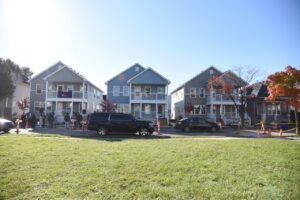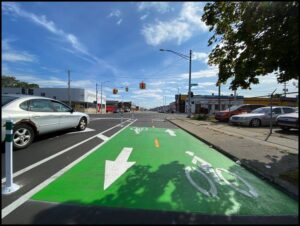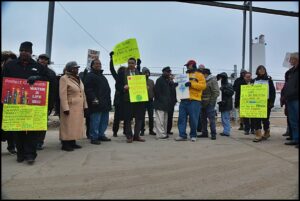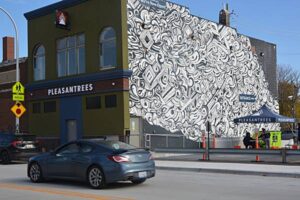Part two of our Year in Review

Once again new flags were flown on Jos. Campau thanks to generous donations by residents and businesses.
By Charles Sercombe
Just as we promised, we’re back this week with Part Two of our Year in Review.
As usual, Hamtramck may be a small town, but it packs in a lot of news in any given year.
JULY
One of the hardest hit industries during the era of COVID has been that of bars and restaurants, which was restricted to limited indoor service, and encouraged to expand their outdoor dining areas.
Hamtramck also jumped on board, by encouraging bars and restaurants to create sidewalk cafes.
The council loosened the rules for those businesses to be able to do so, and several wasted little time in accepting the council’s invitation.
City Manager Kathy Angerer said that permitting expanded dining areas outside would help businesses make money.
“This change would not only allow business owners to offset losses in revenue due to COVID-19 over the past several months, but would also put on display the vibrancy and dynamism of our small business community,” Angerer said.

The city loosened its rules about sidewalk cafés in response to the shutdown of indoor dining at restaurants.
Gov. Gretchen Whitmer also recommended expanding outdoor dining.
“… the data shows that it’s safer than indoor seating (to be outside), and we should take full advantage of spring-time weather — and that is what we are hoping to do here,” she said, back when it was still spring.
In the coming months, the city council may decide to continue the program permanently.
We’ll drink to that.
Jos. Campau was suddenly looking a lot more colorful.
That’s because the annual raising of international flags was held in early July.
A small flag-hoisting ceremony was held outside the Piast Institute, where a Polish flag was raised. Accompanying that flag raising were dancers from the Gwiazda Dance Troupe.
That was the first of 10 flags to go up, which represent the many nationalities who live here. They included not only the Polish flag, but also those for the countries of Albania, Bosnia, the Ukraine, Bangladesh, Yemen, South Korea, the Philippines, Jamaica and, of course the United States.
Russ Gordon, who coordinates both the purchasing and raising of the flags, said he is always seeking donations. Specifically, in order to buy several more flags, which often only last one season before starting to look too worn out.
If you’d like to get a head start and donate for next year, you can contact Gordon at (248) 442-8000 (his office), or (248) 842-7373 (his cell).
In an unexpected announcement, Hamtramck School Board Vice President Maggie Srodek submitted her resignation.
Srodek, who had served on the board for eight years, many of them as president, said it came down to time with family.
“It’s been a lot of everything, and not enough time in the day for my family,” Srodek told The Review.
Srodek’s family owns Srodek’s Campau Quality Sausage Company on Jos. Campau, and recently opened a new market in Sterling Heights. Srodek also recently had a child.
At a special school board budget meeting on June 29, Srodek submitted her resignation, which became effective after that meeting.
She told the board that her decision didn’t come easy.
“It pains me, but it is the right decision,” Srodek said.
Srodek was replaced by Daz’Shavon Hall.
She has a degree in criminal justice from Wayne State University.
Hall, 28, is the third African-American to sit on the board, following Yvonne Myrick and Titus Walters.
In her interview, Hall told the board that her role as a boardmember is “to be here, and be able to give feedback.”
Hamtramck’s historic baseball stadium took a major league step toward a historic change.
Contractors began tearing out the old turf and infield to make way for a brand-new field.
Work also began on making repairs to the stadium building itself.
The stadium is considered historic because it is one of only five stadiums built specifically for the old Negro League Baseball that are still standing today.
It was built in 1930, and was home to the legendary Detroit Stars. This was at a time when African-Americans were not allowed to play in whites-only Major League Baseball.
Later in the month, a $500,000 federal grant came through to help with repairs at the stadium.
For any high school graduate in the Class of 2020, this was one strange school year.
A good chunk of the year in Michigan — and Hamtramck – was no exception — was spent learning at home via online courses.
The reason, as we all know too well, is the coronavirus pandemic, which is still causing more and more people to come down with COVID-19, the disease caused by the virus.
In order to safeguard our school kids, in-school learning was canceled.
It was against this backdrop that Hamtramck High School and Horizon High School grads graduated.
At least, this portion of the school year was done in-person. But it wasn’t your typical ceremony.
Instead of all grouping together, the students arrived at Keyworth Stadium in batches of 75. They all signed up ahead of time to arrive at the stadium in those smaller groups, in order to keep social distancing intact.
Hamtramck’s second homicide of the year occurred early on the morning of Friday, July 10.
At the time, police say they had little information about the circumstances of a shooting death of a Detroit man that happened around 2:30 a.m. in the area of Grand Haven and Circle Dr.
Police were seeking the help of witnesses.
According to a press release, officers responded to a call about gunshots being fired in that area.
Upon their arrival at the scene, Kiywon Ballard, 30, of Detroit, was found, suffering from a gunshot wound.
Ballard died later at a local hospital.
The case is still open.

Businesses along Holbrook, such as Café 1923, were hard hit by the COVID crisis and the reconstruction of the street all summer.
First came the coronavirus pandemic and the shutting down of non-essential businesses.
Then came the closing of Holbrook between Lumpkin and Jos. Campau to rebuild the street and install new water lines.
These double-whammies were a one-two punch for the owners of Café 1923, among others along that stretch.
Shannon Lowell, a co-owner, said at the time that, although he was allowed to re-open the café, the street repair had shut down customers from coming.
And then, there was one more blow.
The mail had stopped being delivered there.
“The only reason I know when my mortgage is due is through the mail,” he said. “What with the quarantine and then closing, I’ve lost all track of time.”
AUGUST
Plans for both building a new school and for making major repairs to existing school buildings were put on hold.
Hamtramck voters overwhelmingly rejected the public school district’s bond proposal to raise property taxes by seven mills for up to 30 years.
Those voting against it totaled 2,571, and those for it totaled 1,380.
If it had passed, it would have raised $35 million.
The millage proposal had faced steep opposition. On social media, particularly Facebook, residents — including former Hamtramck School Boardmember Nasr Hussain — spoke out against the proposal.
Also joining in the opposition were the vice principal of Kosciusko Middle School, Christina Adamczyk, and her husband David, who has done some work for the district. They created a Facebook page dedicated to defeating the millage. Hussain also created a Facebook page campaigning against the proposal.
The Hamtramck Public School Board was in for a big change.
School Boardmembers Evan Major and Dennis Lukas have joined Maggie Srodek, who recently resigned, in not seeking re-election.
That means there will be four new board members this year.
Asked why he is stepping down, Major said this, in an email to The Review:
“I’ve dedicated the last seven years to building a better board and a better school system. Some of the key elements are now in place to continue progress, such as the transition to a new Superintendent, a three-year strategic plan, consistent enrollment growth, wage growth, annual budget surpluses, and above all, the remarkable students, staff, and families that help our reputation shine far beyond our small borders.
“I look forward to transitioning the new board, focusing on the root causes of challenges in public education, and reemerging as an active HPS parent in a few years.
“But most of all, I look forward to voting YES on the bond initiative on August 4th, because every possible option has been studied, and this is our best chance to give thousands of students a better chance in life.”
Dennis Lukas, a retired science teacher with the Hamtramck district, said he is not seeking re-election because he felt it was time “to let other people join the board.”
Lukas added that the board was taking a different direction than he had hoped.
“I had more things I wanted to do on the board,” he said. “I was thinking of academics, but they wanted more social programs.”
Well, finally some good news for the city.
At least, if you’re a property owner – or, thinking of becoming one soon.
Insurify, an insurance comparison shopping website, named Hamtramck as its top up-and-coming city for the entire state, with regard to property values.
Factors driving the nation’s surprisingly robust real estate market during the coronavirus pandemic include: some people wanting to move out of urban centers for safety-related reasons, and others now working more from home, who either desire more workspace, or who no longer care as much about being close to their jobs.
Despite protests against allowing a recycling center located just outside of Hamtramck to handle radioactive waste, the state cleared the way for the company to operate.
Protestors continued to fight back.
The Great Lakes Environmental Law Center filed a lawsuit against the Michigan Department of Environment, Great Lakes, and Energy (EGLE) for giving the US Ecology North facility the go-ahead.
The law center noted that these types of facilities are usually located near neighborhoods where a large percentage of the population consists of minorities.
According to the law center, seven out of eight such facilities in the state that handle hazardous and toxic waste are located in predominantly minority areas.
The lawsuit sought to end this practice, and “(sought) not only to ensure compliance with the federal civil rights law to which it is bound, but also to aid EGLE in achieving its mission of assuring environmental justice for all Michiganders,” the law center said in a press release.
During one of her weekly addresses to the community, via Facebook, about the ongoing COVID crisis, Mayor Karen Majewski said that she had herself tested positive, but was now free of the disease.
With her voice slightly faltering, she said in her live stream:
“Despite wearing a mask in public, and in open air and on the street, and in closed spaces — avoiding groups as much as possible — I have now tested twice positive for COVID-19.”
Although she tested positive for the disease, Majewski said she had been largely asymptomatic, despite some minor symptoms “that normally I wouldn’t give a second thought to.”
The main symptom, she later told The Review, was a persistent sore throat, which was what had prompted her to see a doctor and get tested.
Yes, Hamtramck Public School students would be returning to school this past fall.
But they would not be in classrooms. Instead, they continued with virtual learning, just where they left off in June when the 2019-20 school year let out.
Hamtramck Public Schools continued to offer in-person assistance for students, and its buildings would remain open.
The new school-year plan included:
• Real-time, live instruction
• Screening tools to identify students in need of additional support
• Mentors for students who need additional support, and to monitor for attendance, assignment submission, and progress as needed
• Parent Liaison, and School and Community, Facilitators to connect parents and students to resources
• Breakfast and lunch programs, including for weekend days
The Yemeni community took to the streets, in protest of the ongoing war and famine happening in their native country.
For the past several years, the country of Yemen has been under siege.
This lethal mix of war and famine stirred the local Yemeni community, which has become Hamtramck’s latest political powerhouse, to actively protest together.
It was on Wednesday and Thursday evenings, August 19 and 20, when the Yemeni community, along with what appeared to be some outside sympathizers, gathered at Veterans Memorial Park to demonstrate in Yemen’s support, and make the public aware of what’s happening there.
The gathering was sponsored, in part, by a group called Detroit Will Breathe.
Akil Alhalmi, of Hamtramck, told The Review that the situation in Yemen is dire.
“The whole country is dying,” said Alhalmi, who has family in Yemen. “And the whole world is watching, and no one cares. They (the Saudis) bomb wedding parties, and we don’t see anything going on.”
A number of speakers and others have focused on the role of the US, which has been selling billions of dollars’ worth of weapons to Saudi Arabia.
The arms sale, Alhalmi said, “blinds their eyes,” referencing the US government.
After a couple of speakers outlined the hardships that Yemenis are facing, a march began from Veterans Park through the streets of the south end, where most of Hamtramck’s Yemeni community live.
Taking a cue from the Black Lives Matter movement, a chant, accompanied by a snare drum march beat, was repeated over and over: “Yemeni Lives Matter.”
SEPTEMBER
The first weekend of September is usually a time of much celebration for Hamtramck.
That’s when the annual Hamtramck Labor Day Festival takes over the town. But the festival had to be canceled this year because of COVID safety concerns.
And if that wasn’t enough of a letdown for many, Hamtramck also lost one of its most colorful characters, Alan “Tex” Booker, who died sometime this year.
It appears that he likely died sometime this past year at the age of 70 or 71. There were no other details available about his death.
“Tex,” as everyone in town knew him, was a both a fixture and an attraction all by himself at the festival and, every year, offered his services as a security guard.
Those commenting on various Facebook pages were saddened and shocked upon hearing of his passing.
Festival co-organizer Konrad Maziarz had this to say:
“It is with great sadness that I recently found out that Tex had passed away. As much as he would drive me crazy during the festival, he was always there, and he truly loved the event and this city, and he will be missed. Hopefully you’re finally enjoying the hoedown you always wanted this city to throw. RIP Tex.”
Mayor Karen Majewski joined other mayors across the country in condemning the use of federal officers to quell protests.
In a number of such instances, which alarmed civil rights advocates, the officers were observed wearing military gear with no identification, and were also refusing to identify themselves when confronted by the public.
In what appeared to be a first for a Hamtramck mayor, Majewski issued an executive order that called for Hamtramck police to intervene in, and make arrests of, anyone claiming to be a federal officer but refusing to identify themselves.
Hamtramck continued to attract murals.
The city’s latest mural explores the COVID-19 crisis, and how it has affected lives here.
On a Sunday afternoon, an unveiling of the newest mural, called “Culture and Quarantine,” took place at the former Shopper’s World, where it spans the building’s 17 front windows.
The mural was painted by Detroit artist Nicole Macdonald, and sponsored by OneHamtramck, a self-described “community-based peace and justice organization.”
The building, located on Jos. Campau in the heart of the Hamtramck business community, has been under renovation for a few years, and is currently owned by City Councilmember Mohammed Alsomiri.
A press release issued by OneHamtramck explains what is happening in each of the separate window panes of the mural.
“The subjects selected are seen behind, and interacting through, windows, showcasing the period of separation and isolation during quarantine, as well as the efforts made to connect and support each other through a difficult time,” the press release said.
“While some subjects are depicted in quarantine at home, others are shown in their frontline positions, risking their lives to provide food, transportation, and other essential goods and services.”
There was more action at Hamtramck’s historic baseball stadium.
Not only was there a new infield, the whole field (separately from the stadium) was given an honorific name: “Norman ‘Turkey’ Stearnes Field.”
Stearnes was a legendary player who played in the Negro Baseball League back in the 1930s, when African-Americans were barred from playing in the all-white Major Leagues.
He played with the Detroit Stars, whose home field was Hamtramck Stadium.
According to the National Baseball Hall of Fame website, Stearnes was one of the best hitters in the league.
He was born in 1901 in Nashville, and it is said that he got his nickname “because of the unusual way he ran, which resembled that of a turkey, with his arms flapping.
“However, Stearnes himself claimed it was because he had a potbelly as a child,” the Hall of Fame website said.
Stearnes died in 1979, and was elected into the Hall of Fame in 2000. He has family that still live in Detroit.
The clock was ticking down for Hamtramck households to take part in the national Census count.
The last day for the count was Sept. 30.
The Census happens just once every 10 years across the country, in an effort to determine the nation’s population.
The Census is far more than a national headcount. It is also used to draw up congressional districts, and assign the correct number of state representatives. The Census count also determines how federal funds and grants are apportioned for communities.
In 2010, the Census count for Hamtramck was 22,423 – which a number of city officials said was an undercount. It was – and still is — believed that a more accurate population count for the city would be about 30,000.
In 2019, the Census Bureau estimated Hamtramck’s population went down to 21,599. The Census also noted that over 44 percent of the residents were foreign-born, and that 49 percent of the population is female.
OCTOBER
The presidential election began with early mail-in voting. And Hamtramckans responded.
Over 4,600 voters asked for ballots.
Interest in early voting was also shared by voters statewide. According to the state’s Secretary of State’s Office, over 2.5 million ballots were requested.

J&E Community Relief has grown from a grassroots organization to one that provides several services to the community – including much needed food giveaways. Photo supplied by J&E Community Relief.
As the economy continued to shrink while the COVID crisis continued, a number of local food banks stepped up to assist residents.
J&E Community Relief, located on Jos. Campau, was one of those organizations.
We talked with the founder of the organization, Emina Ferizovic, about her mission, and what inspired her.
“In 1996, at age 12, I came to Hamtramck — as a refugee from Bosnia. I have always felt the need to give back to this community, and help those in need,” she told us.
Whippets, usually used in baking, became a thing.
As in, a nuisance for many communities – Hamtramck included.
Young folks inhale the nitrous oxide inside the small cannisters to get a momentary high, and then discard the containers on the ground.
You can see them everywhere, and plenty of folks were complaining, throughout the year, about the litter.
Detroit took the lead in battling the problem.
The online news publication Deadline Detroit recently reported on an effort, in southwest Detroit, to make residents there more aware of the problem.
Deadline Detroit quoted Frank Venegas Jr., of “The Southwest Detroit Whippet Wipe-Out Campaign,” as saying:
“This behavior can be incredibly dangerous — and even fatal in some instances — and it creates a public safety issue, when thousands of empty cartridges are littered in our streets and parking lots.
“The small cartridges get in our tires, and cause flats and blow-outs, and are a danger to pedestrians, cyclists, and those traveling on scooters.”

Friends of Historic Hamtramck Stadium founder Gary Gillette (left) and retired auto designer Vince Geraci present the family of Baseball Hall of Famer Norman “Turkey” Stearnes with custom commemorative baseball jerseys Sept. 29 at Hamtramck Stadium. (Photo by Dave Mesrey)
Legendary baseball player Norman “Turkey” Stearnes finally had his homecoming at Hamtramck’s historic baseball stadium.
Unfortunately, he died back in 1979.
But his two daughters were on hand to witness the official dedication of the stadium’s field — which has been named in Stearnes’ honor — on Tuesday afternoon, Oct. 6.
Stearnes was part of the old Negro (baseball) Leagues back in the 1930s, and played with the Detroit Stars at the Hamtramck Baseball Stadium, which was built in 1930 and is one of only a handful of such stadiums still standing.
The stadium is undergoing a massive multi-million-dollar renovation, including the newly installed – and renamed — infield.
Mike Williams, President of the Friends of Historic Hamtramck Stadium, an organization that has been key in unearthing the historical importance of the site, said that the transformation of the stadium would make the former Negro league players “proud.”
Jaleelah Ahmed, the Superintendent of the Hamtramck Public School District, said the stadium serves as a “symbol of determination” for black players overcoming prejudice, and making their own mark in this country.
The year 2020 is going to be remembered for a lot of things, but in Hamtramck, one of the welcome developments was road repairs.
First up, the Holbrook repaving project continued where it left off last year, from Jos. Campau to Lumpkin. This is now the second half of the project, which also included last year’s repaving of Holbrook from Jos. Campau to Conant.
Carpenter St. also was newly repaved, from Dequindre to Conant. Carpenter had been one of the worst potholed streets in the city.
The City of Detroit handled that project. Also repaved, on the neighboring Detroit side, was Jos. Campau, from Carpenter to Davison.
Conant Ave. also joined the list.
The county-owned road had been repaved north of Carpenter recently, but that project stopped at the Hamtramck border.
After years of complaining, the county will now continue with that project, and repave Conant from Carpenter to Holbrook.
Can the city’s nightlife survive the era of COVID?
That’s a topic we briefly explored, as many restaurants and bars struggled to survive the semi-shutdown of their businesses.
We ventured over to Café 1923 (located at 2287 Holbrook) on a Sunday afternoon, where a soft re-opening was held.
Co-owner Shannon Lowell had spent the past several months undergoing a re-model of the coffee house, from top to bottom.
He wiped down the ceiling and walls, re-painted, sanded the wooden floors by hand, re-grouted, fixed a leak in the bathroom, put UV protection on the windows, and made several other improvements.
While we celebrated the return of Café 1923, we also heard some disturbing talk about four Hamtramck bars, including one that is a major music hall, that are closing down, and even be up for sale.
The situation continues to be grim for local businesses.
The Census count came to an abrupt end.
A federal court allowed the Trump administration to end the national headcount three weeks early.
The count was supposed to run until the end of October, but stopped on Oct. 15.
So, what did that mean?
In all likelihood, there will be an undercount in many inner-cities, observers have said.
Hamtramck’s participation was estimated at about 63 percent. Statewide, the average was about 71 percent.
Virginia Skrzyniarz, Hamtramck’s Complete Count Chairperson, said she was disappointed that the count ended early.
She said that getting the word out about the Census was already challenged by both the COVID crisis and the upcoming presidential election. She said there was a “lack of emphasis on the 2020 Census” by federal officials.
“Communities like ours,” Skrzyniarz said, referring to Hamtramck’s multi-ethnic makeup, “are the losers.”
Mayor Karen Majewski said she was “alarmed” over the early ending.
“I see the low count as a failure at multiple levels — local and national,” she added.
What’s at stake for Hamtramck are federal grant monies and congressional representation. Simply put, it looks like Hamtramck will see a reduction in federal aid for the next 10 years – until the next Census takes place.
NOVEMBER
Hamtramck voters overwhelmingly rejected three city ballot proposals.
Over 7,000 voters participated in this election – making it the highest turnout in decades.
There are over 9,000 registered voters in Hamtramck. Over 5,000 ballots were cast via absentee ballot.
As usual, voters here overwhelmingly supported the Democratic presidential candidate – this time, it being Joe Biden’s turn.
Hamtramck’s ballot proposals were as follows:
Proposals 1 and 2 asked voters whether to eliminate from the city charter the language establishing the police and fire departments, as well as their respective chiefs.
Hamtramck firefighters waged a campaign against the proposals, and were out in force at the polling stations on Tuesday.
The third proposal asked voters to allow the city to increase a property tax that funds the pension cost of police and fire retirees, from a half mill to up to 10.5 mills.
The state representative race that includes Hamtramck in its district was won easily by Abraham Aiyash. Aiyash fills the seat left vacant by Rep. Isaac Robinson, who died earlier this year, at age 44, of COVID-19.
Aiyash is the first Hamtramck resident since the 1990s to fill that position.

A new housing development was completed in the southend of the city. The new housing will be home to recent immigrants.
Hamtramck’s new housing development was ready for occupancy.
Three two-family houses were constructed on Faber St., and they are being dubbed “Freedom Village.”
That’s because the housing is reserved for refugee families who have escaped from war-torn countries.
The families will only stay for several months before resettling somewhere else, which will then make room for another batch of new refugees to begin to acclimate to their newly adopted country.
A couple of main reasons that Hamtramck was selected for this project are: because the city’s ethnically diverse, and because it is a walkable community, where you can easily do your shopping close by and not need transportation.
There was plenty of buzz about Hamtramck’s newest business.
The city’s first recreational marijuana shop opened at a renovated veterans post building at 2238 Holbrook Ave., next door to Kowalski Sausage Co.
The opening caught a number of folks by surprise considering that, just two years ago, Hamtramck went through a heated public debate on whether to allow marijuana dispensaries and grow facilities to locate here.
There was a huge pushback from both the Yemeni and Bangladeshi communities about allowing those types of businesses to exist in Hamtracmk. Many of the critics said they were concerned about marijuana shops attracting crime, and that their presence would influence their children.
While there was stiff opposition, there was one thing the Hamtramck City Council didn’t do: Choose to “opt in” – which would open the doors for the businesses – or “opt out,” which would have prohibited them.
Since the council chose none of the above, state law allows marijuana shops to open in the community.
The outlet is part of a chain called Pleasantrees, and its headquarters is located in Harrison Twp. So far, the company has just one other store, which is located in East Lansing.
COVID hit city hall.
City Clerk August Gitschlag, along with two employees in his office, tested positive for the disease.
All of them survived, and returned to work.
The outbreak upset a number of election workers, who complained that they were not contacted by the city.
DECEMBER
Hamtramck was about to get its second marijuana retail outlet.
But its go-ahead took some legal maneuvering, before city officials signed off on the deal for a building located at 2024 Caniff Ave.
Initially, the city’s Zoning Board of Appeals narrowly rejected a request made by Hosh Investments, LLC, the owner of the property, and Quality Roots, Inc., the would-be outlet retailer, to rezone the building, which is next to a gasoline station and some other vacant lots, just east of the I-75 freeway.
Despite the warnings by two city attorneys that the building had previously been used for commercial purposes, and that the ZBA can’t discriminate against a legal business, the initial request was voted down 3-2, with one ZBA member, Eric Anderson, abstaining.
City Attorney Jim Allen’s prediction that a lawsuit would be promptly filed proved accurate. Days later, a lawsuit was filed in Wayne County Circuit Court to not only allow the zoning variance to go through, but also to put on hold a city council proposal to adopt an ordinance banning marijuana sales outlets from operating in the city.
Upon the request of the city council and City Attorney Allen, the ZBA reconsidered its vote and decided to approve the zoning request.
Soon after, a bare majority of the council approved an ordinance banning future marijuana outlets from opening.

A bike path on Jos. Campau that stops at Carpenter will be coming into Hamtramck sometime next year. One sticking point is what to do with it when Campau narrows south of Caniff.
A new bike lane on Jos. Campau between Carpenter and McNichols will extend into Hamtramck.
It’s just a matter of how it will cut through the city, said City Manager Kathy Angerer.
While Jos. Campau is wide enough going south from Carpenter to Caniff, past that intersection there’s a bump in the road, so to speak.
That bump is, what to do with the bike lane as it continues south of Caniff, where Campau becomes much narrower.
There are a couple of options: slim the lane down greatly, or wind it through an alley running adjacent to Campau.
Since the street is owned by Wayne County, it will be the county’s final design decision going forward.
In total, the path totals over 27 miles that are set aside for biking and walking, and it extends from downtown Detroit’s Dequindre Cut, up through Highland Park, then into Hamtramck. It also spikes west to Dearborn.
The bike path is being called — in honor of Detroit boxing legend, Joe Louis — the Joe Louis Greenway.
Well, that does it for the Year in Review. Come back next week, when we resume our regular coverage of the city.
Posted Dec. 31, 2020









Resident
December 31, 2020 at 9:39 pm
Happy New Year!!! Hoping there is a better year ahead.
Hoping people get COVID-19 vaccine on first opportunity.
Hoping City Council wise up and allow and set limit (5 or 10 or 25…) and regulate dispensaries.
-Resident